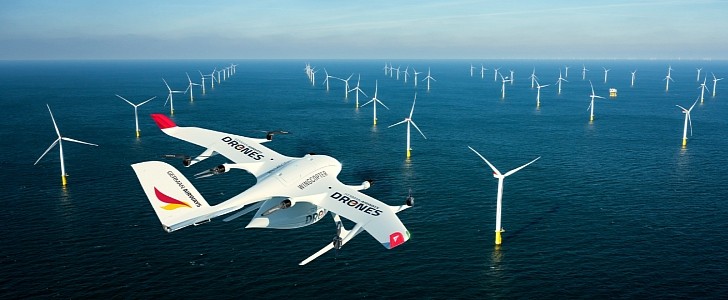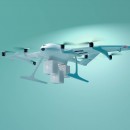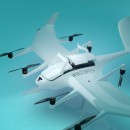Up until now, we mostly heard about Wingcopter’s drones as serving the healthcare sector, transporting medical supplies in different parts of the world. But now the German manufacturer announces a partnership that will see its UAVs (unmanned aerial vehicles) delivering spare parts for offshore wind farms.
German logistics and aviation company Zeitfracht Group and its subsidiary, German Airways, will initially purchase 17 Wingcopter 198 delivery drones for that purpose and might buy an additional 115 units by 2023. The UAVs will be deployed from the second half of 2024.
With this newly signed agreement, the two buyers will be among the first companies in the world to commercially deploy drones in logistics, according to Wingcopter.
The drones will come with advanced technological features to be capable of landing with pinpoint accuracy on moving ships. They will take off from Rostock Airport, which is part of the Zeitfracht Group since the beginning of 2022. That will also be the location where Wingcopter’s team will conduct extensive test flights with its drones.
Wingcopter’s aircraft were chosen for several reasons. The drones are wind and weather resistant, being able to handle the most extreme conditions. They don’t require additional infrastructure, as they take off vertically. Once in the air, they transition to horizontal flight just like an airplane.
These electric flying machines have a wingspan of 78” (198 cm) and can fly at a top speed of 90 mph (144 kph). They can reach altitudes of 16,400 ft (5,000 m) and use two batteries and eight motors.
As for the range of the Wingcopter 198, it depends on the weight it has to transport. It can fly up to 59 miles (95 km) with a payload of just 2.2 lb (1 kg), 53 miles (85 km) with a payload of 6.6 lb (3 kg), and 46 miles (75 km) when carrying 11 lb (5 kg).
With this newly signed agreement, the two buyers will be among the first companies in the world to commercially deploy drones in logistics, according to Wingcopter.
The drones will come with advanced technological features to be capable of landing with pinpoint accuracy on moving ships. They will take off from Rostock Airport, which is part of the Zeitfracht Group since the beginning of 2022. That will also be the location where Wingcopter’s team will conduct extensive test flights with its drones.
Wingcopter’s aircraft were chosen for several reasons. The drones are wind and weather resistant, being able to handle the most extreme conditions. They don’t require additional infrastructure, as they take off vertically. Once in the air, they transition to horizontal flight just like an airplane.
These electric flying machines have a wingspan of 78” (198 cm) and can fly at a top speed of 90 mph (144 kph). They can reach altitudes of 16,400 ft (5,000 m) and use two batteries and eight motors.
As for the range of the Wingcopter 198, it depends on the weight it has to transport. It can fly up to 59 miles (95 km) with a payload of just 2.2 lb (1 kg), 53 miles (85 km) with a payload of 6.6 lb (3 kg), and 46 miles (75 km) when carrying 11 lb (5 kg).







